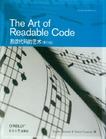易读代码的艺术
出版时间:2012-6 出版社:东南大学出版社 作者:Dustin Boswell,Trevor Foucher 页数:190 字数:250000
Tag标签:无
内容概要
作为程序员,我们经常看到一些充满Bug、让我们头痛不已的丑陋代码。在过去五年中,《易读代码的艺术(影印版)》的作者博斯韦尔(Dustin
Boswell)和富彻(Trevor
Foucher)分析了许多这样的“糟糕代码”(这些代码有很多是出自于他们自己之手),他们试图厘清为什么这些代码如此糟糕以及如何改进这些代码。他们得出的结论是:你必须写出让他人(这里也包括你自己)花费最少时间能够理解的代码。
作者简介
Dustin Boswell,毕业于加州理工学院,在谷歌公司从事过五年的Web信息采集基础设施和广告营销计划的研究工作。他先后构建过多个Web站点,目前的主要研究兴趣在于大数据的处理和机器学习领域的相关技术。 Trevor Foucher,过去十年中先后在微软公司担任Windows及安全相关产品的工程师、经理和技术领导者的职务,现任职于谷歌公司,主要从事谷歌广告营销计划和搜索基础设施的研究工作。
书籍目录
PREFACE
CODE SHOULD BE EASY TO UNDERSTAND
What Makes Code "Better"?
The Fundamental Theorem of Readability
Is Smaller Always Better?
Does Time-TilI-UndetandinR Conflict with Other Goals?
The Hard Part
Part One SURFACE-LEVEL IMPROVEMENTS
PACKING INFORMATION INTO NAMES
Choose Specific Words
Auoid Generic Names Like Imp and retual
Prefer Concrete Names ouer Abstract Names
Attachin9 Extra Information to a Name
How Lon.g Should a Name Be?
Use Name Formatting to Conuey Meaning
Summary
NAMES THAT CAN'T BE MISCONSTRUED
Example: FilterO
Example: Clip(text, length)
Prefer rain and max for (Inclusiue) Limits
Prefer fit and last for Inelusiue RanRes
Prefer herin and end for.lnclusiue/Exclusiue RanRes
NaminR Boolea
MatchinR Expectatio of Use
Example: EualuatinR Multiple Name Candidates
Summary
AESTHETICS
Why Do Aesthetics Matter?
BearranRe Line Breaks to Be Coistent and Compact
Use Methods to Clean Up IrreRularity
Use Column AliRnment When Helpful
Pick a MeaninRful Order, and Use It Coistently
OrRanize Declaratio into Blocks
Break Code into "Parafgraphs"
Peonal Style ueus Coistency
Summary
KNOWING WHAT TO COMMENT
What NOT to Comment
Becordin9 Your Thouyhts
Put Youelf in the Reader's Shoes
Final Thoughts--Getting Over Writer's Block
Summary
MAKING COMMENTS PRECISE AND COMPACT
Keep Comments Compact
Avoid Ambiguous Pronou
Polish Sloppy Sentences
Describe Function Behavior Precisely
Use Input/Output Examples That Illustrate Corner Cases
State the Intent of Your Code
"Named Function Parameter" Comments
Use Information-Dee Words
Summary
Part Two SIMPLIFYING LOOPS AND LOGIC
MAKING CONTROL FLOW EASY TO READ
The Order of Arguments in Conditionals
The Order of if/else Blocks
The ?: Conditional Expression (a.k.a. "Ternary Operator")
Avoid dogwhile Loops
Returning Early from a Function
The Infamous goto
Minimize Nesting
Can You Follow the Flow of Execution?
Summary
BREAKING DOWN GIANT EXPRESSIONS
Explainin9 Variables
Summary Variables
Using De Morgan's Laws
Abusing Short-Circuit Logic
Example: Wrestling with Complicated Logic
Breaking Down Giant Statements
Another Creative Way to Simplify Expressio
Summary
VARIABLES AND READABILITY
Eliminatinfg Variables
Shrink the Scope of Your Variables
Prefer Write-Once Variables
A Final Example
Summary
Part Three REORGANIZING YOUR CODE
EXTRACTING UNRELATED SUBPROBLEMS
Introductory Example: findClosestLoeationO
Pure Utility Code
Other General-Purpose Code
Create a Lot of General-Purpose Code
Project-Specific Functionality
Simplilying an Existing Interface
Reshaping an Interface to Your Needs
Taking Things Too Far
Summary
ONETASK ATA TIME
Tasks Can Be Small
Extracting Values from an Object
A Larger Example
Summary
TURNING THOUGHTS INTO CODE
Describing Logic Clearly
Knowing Your Libraries Helps
Applying This Method to Larger Problems
Summary
WRITING LESS CODE
Don't Bother Implementing That Feature--You Won't Need It
Question and Break Douan Your Requirements
Keeping Your Codebase Small
Be Familiar with the Libraries Around You
Example: Using Unix Tools Itead of Coding
Summary
Part Four SELECTED TOPICS
TESTING AND READABILITY
Make Tests Easy to Read and Maintain
What's Wrong with This Test?
Making This Test More Readable
Making Error Messages Readable
Choosing Good Test Inputs
Naming Test Functio
What Was Wrong with That Test?
Test-Friendly Deuelopment
Going Too Far
Summary
DESIGNING AND IMPLEMENTING A "MINUTE/HOUR COUNTER"
The Problem
Defining the Class Interface
Attempt 1: A Naiue Solution
Attempt 2: Conueyor Belt Design
Attempt 3: A Time-Bucketed Design
Comparing the Three Solutio
Summary
FURTHER READING
INDEX
媒体关注与评论
“意识到你所编写的代码如何影响他人的阅读和理解是软件开发中的一个重要环节。本书的作者通过大量启发式的例子带领读者从多个不同的方面去迎接这一挑战,在这一领域做出了伟大的工作。” ——Michael Hunger,软件开发人员,Neo Technology
图书封面
图书标签Tags
无
评论、评分、阅读与下载
用户评论 (总计10条)
- 不错的,就是买错了,买了本纯英文的
- 读这本书,感觉不太好,如果出版翻译后的肯定会更受欢迎。排版不是很好,如果字体颜色鲜明会更好。
- 对于初学者来说,书里面的内容都是很有必要学习的,英语也都很直白易懂,推荐!
- 对自己平时写代码又很好的参考价值,代码的工整性
- 写得通俗易懂,对于实际应用场景很实用,英文表达也很通俗,生动
- 我觉得影印版应该在多点。很给力啊。学习力英文,又能看到大神的思想。。
- 很好很强大, 原本以为是 中文的 ~~
- 内容还不错,适合提高代码质量
- 内容很不错,很适合业内人士阅读,印刷也很清楚,这种书还是读英文版的比较好
- 关于代码编写提供了很有价值的一些建议,还是不错的。
相关图书
- 第六届全国工科研究生教育工作研讨会论文集
- 中国城市设计层次与形态
- 实用商务英语会话
- Perl语言编程
- 全国第四届钢笔画展优秀作品集
- 止于至善
- 数控机床
- 园林绿化工程识图与预算快学一本通
- 汽车保养灯归零、遥控防盗、设定编程及初始化速查手册
- 锦囊妙解中学生英语系列 阅读理解 九年级
- 儿童剪纸技法(中英双语版)
- 儿童简笔画图典
- 儿童简笔画图典
- 计算机基础教程
- 电梯结构原理及安装维修
- 锦囊妙解中学生英语系列 九年级阅读理解与完形填空 强化训练
- AutoCAD 2012建筑与室内装饰设计实例精解
- 儿童折纸技法(中英双语版)
- 如此购车最聪明
- 如此开车最聪明
- 锦囊妙解中学生英语系列 单项选择与新题型强化训练 九年级
- 夹具应用实训
- 意志力
- 锦囊妙解中学生英语系列 词汇与语法 强化训练 八年级
- 货币崛起
